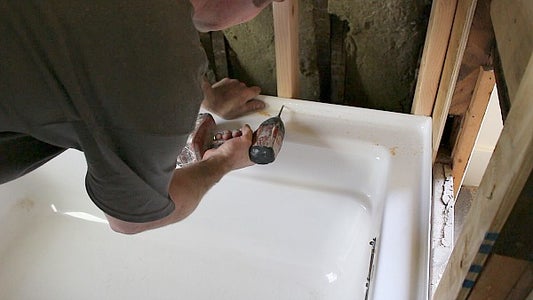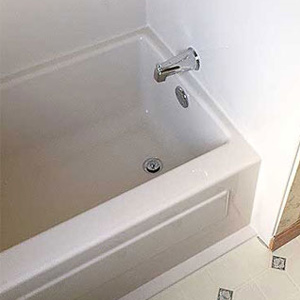Do It Yourself Bathtub Setup.
Do It Yourself Bathtub Setup.
Blog Article
Each person is bound to have his or her own assumption about How to Install a Bathtub: Install an Acrylic Tub and Tub Surround.

Installing a bath tub isn't specifically brain surgery, yet it does need strong plumbing, carpentry, as well as in some cases, tiling skills. Replacing an old bathtub with a brand-new one is additionally a reasonably hard task. If the old bathtub is easily available, the project can move easily; if you need to open up a wall to remove the old tub and also place the brand-new tub, the task is much harder. In either instance, the task is within a house handyman's skills, although you will require an assistant to leave the old tub and embeded in the brand-new one. Make certain you have qualified on your own for the task as well as are comfortable trying it. As opposed to employing a professional to take over a halfway-completed task, it is much better to think about employing one prior to you start. Possibilities are you may require an expert plumber to make tube connections.
This write-up will certainly assist you install a brand-new tub in your bathroom if you have actually already gotten a new bathtub as well as don't require to alter the arrangement of your previous water pipelines.
Your tools and also material checklist must comprise the following:
Removing Old Taps
If you need to replace old faucets with new ones as a part of your installment, then the first thing you should do is detach the water supply. After doing so, activate the taps to drain pipes any kind of water remaining in the system. The procedure of eliminating the existing faucets can be rather bothersome because of the limited gain access to that is often the situation.
Use a container wrench (crowsfoot spanner) or a faucet tool to reverse the nut that connects the supply pipelines to the taps. Have a towel ready for the staying water that will come from the pipelines. Once the supply pipelines have been eliminated, make use of the exact same device to loosen the nut that holds the taps onto the bath/basin. You will certainly need to quit the solitary taps from transforming throughout this procedure. When the faucets have been gotten rid of, the holes in the bath/basin will need to be cleaned up of any old sealing substance.
Before carrying on to fit the new faucets, contrast the pipe connections on the old faucets to the new faucets. If the old taps are longer than the brand-new faucets, then a shank adapter is needed for the new faucets to fit.
Suitable New Taps
If the tails of the brand-new taps are plastic, then you will certainly need a plastic adapter to prevent damage to the string. One end of the connector fits on the plastic tail of the faucet and also the other end gives a connection to the existing supply pipelines.
If you need to fit a monobloc, after that you will certainly require minimizing couplers, which connects the 10mm pipe of the monobloc to the common 15mm supply pipe.
Next, place the faucet in the installing opening in the bath/basin ensuring that the washers remain in area between the tap and also the sink. Secure the tap in position with the supplier provided backnut. When the faucet is firmly in place, the supply pipes can be attached to the tails of the faucets. The taps can either be linked by utilizing corrugated copper piping or with regular tap connectors. The former type needs to be attached to the tap ends initially, tightening up just by hand. The supply pipes can later be linked to the various other end. Tighten up both ends with a spanner after both ends have actually been connected.
Setting up the Tub
Making use of both wood boards under its feet, place the bathtub in the needed setting. The wood boards are handy in evenly spreading the weight of the tub over the area of the boards rather than concentrating all the weight onto 4 tiny factors.
The next goal is to guarantee that the tub is leveled all round. This can be accomplished by inspecting the level and also readjusting the feet on the bath tub till the level reviews degree.
To install taps, fit the bottom of the furthest flexible tap connector to the appropriate supply pipe by making a compression join; after that do the very same for the other tap.
Switch on the supply of water as well as inspect all joints and also brand-new pipework for leakages and also tighten them if necessary. Fill the bathtub and likewise inspect the overflow electrical outlet as well as the typical electrical outlet for leakages.
Ultimately, deal with the bathroom paneling as defined in the manufacturer's instruction manual. Tiling and sealing around the bathtub ought to wait till the bath tub has actually been made use of at the very least when as this will certainly resolve it right into its final setting.
Getting ready for the Setup
First of all, the supporting framework supplied with the bathroom must be fitted (if needed) according to the producer's instructions. Next off, fit the faucets or mixer to the tub. When fitting the tap block, it is necessary to see to it that if the faucet comes with a plastic washer, it is fitted in between the bathroom and the taps. On a plastic bathroom, it is likewise sensible to fit a sustaining plate under the taps unit to stop stress on the bathtub.
Fit the adaptable faucet ports to the bottom of the two taps making use of 2 nuts as well as olives (in some cases supplied with the bathtub). Fit the plug-hole outlet by smearing mastic filler round the sink outlet opening, and after that pass the outlet via the hole in the bath. Make use of the nut provided by the producer to fit the plug-hole. Examine the plug-hole outlet for an inlet on the side for the overflow pipe.
Next off, fit completion of the flexible overflow pipeline to the overflow outlet. Afterwards, screw the pipeline to the overflow face which should be fitted inside the bathroom. Ensure you make use of every one of the supplied washing machines.
Connect the catch to the bottom of the waste outlet on the bath tub by winding the thread of the waste electrical outlet with silicone mastic or PTFE tape, as well as screw on the trap to the electrical outlet. Connect the bottom of the overflow tube in a comparable manner.The bathroom must now prepare to be fitted in its final setting.
Tiling Around the Bathtub
In the location where the bathroom meets the floor tile, it is needed to seal the accompanies a silicone rubber caulking. This is important as the installation can relocate sufficient to crack a stiff seal, causing the water to pass through the wall in between the bath as well as the tiling, leading to issues with dampness as well as feasible leaks to the ceiling listed below.
You can choose from a range of coloured sealers to blend in your fixtures and also fittings. They are offered in tubes and also cartridges, and are capable of securing gaps as much as a size of 3mm (1/8 inch). If you have a larger space to load, you can fill it with spins of drenched newspaper or soft rope. Keep in mind to constantly fill up the bath tub with water before sealing, to permit the movement experienced when the tub remains in usage. The sealant can split rather early if you do not take into consideration this activity before sealing.
Conversely, ceramic coving or quadrant tiles can be used to border the bathroom or shower tray. Plastic strips of coving, which are easy to use and cut to size, are additionally conveniently available on the market. It is a good idea to fit the floor tiles using water-resistant or water resistant glue and grout.
Bathtub Installation
How Important Is A Bathtub To Your Home?
High-quality baths, showers, and other bathroom updates are necessary when considering a smart investment in your home. It’s a room that you go to every day and one that is constantly being used by guests.The bathroom is one of the top trafficked rooms in a home and also one of the most valuable in terms of home resale.
Install Piping Before Tub
You will be using your existing drain and waste vent system, but pipes required include the hot and cold water supply lines and a pipe leading to a shower head. A mixing valve and shower head are also needed. Air chambers may be required.
Position the Tub
Lower the tub into place so that the continuous flange fits against the wall studs and rests on 1’x4' or 2’x4' supports. Anchor the tub to the enclosure with nails or screws inserted through the flanges into the studs.
NOTE: Remember, bathtubs and shower stalls may require support framing. A bathtub filled with water is extremely heavy, so check building codes and framing support before installing the tub.
Assemble Drain Connections
Assemble the bathtub drain connections by connecting the tub overflow with the tub drain above the trap, not beyond it. The trap will have a compression fitting that screws over the arm of the overflow assembly.
Place a Pipe For the Shower Head
First, locate a brass female threaded winged fitting and attach it to a framing support via a screw or a nail. Then run a pipe up the wall for the shower head. Sweat or solder the other side of the brass fitting to the top of the pipe.
Attaching Hot and Cold Water Lines
Attach your water lines for both hot and cold by sweating these directly into the hot and cold ports of the mixing valve. The mixing valve will be how water enters the tub’s system, not by the pipes themselves.
Install the Spout
Extend a piece of 1/2 inch pipe, or whichever length is specified in the manufacturer’s instructions, for the tub spout. Sweat on a male threaded fitting at the end of the pipe or use a brass nipple of the proper length and a 1/2 inch cap.
NOTE: At this point you should have your rough-in plumbing work inspected before proceeding further.
Check For Leaks
Restore the water pressure and check the drain connection and the supply pipes for any sign of leaking.
estore the Bathroom Wall
Replace the wall with moisture-resistant drywall as a base for your wall covering. Seal the joints between the wall and your new tub with silicone caulk as protection against water seepage.
https://www.berkeys.com/2016/12/02/bathtub-installation-dallas/

I'm certainly very serious about How to Install a Bathtub Yourself and I am praying you enjoyed reading the piece. Liked our piece of writing? Please share it. Help another person check it out. I thank you for reading our article about How to Install a Bathtub Yourself.
Book-Now Report this page